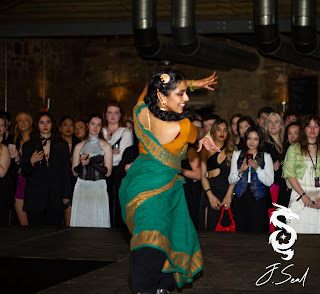Sitara – The Sustainable Star of St Andrews Fashion Shows
by Katie McKenzie
Sitara, meaning star in Hindi, is known to be the most culturally diverse fashion show in St Andrews. Challenging stereotypes and celebrating Asian culture, Sitara provides a safe space for students in a university town where diversity is often lacking.
This year’s show – KALA – focused on the arts and the temporality of nature, celebrating, and understanding the beauties and cultures around us. The show aimed to consider the boundaries of time, fate, destiny, and death through both figurative and visual representation. Through dance, painting, performance, and music, KALA ambitiously attempted to tie humanity together as one.
The array of talented and visionary designers in attendance was beyond what you would expect at a student fashion show. Sitara presented an eclectic mix of designers, with note to various cultures and design techniques, many of which were sustainable. In what follows, I highlight a few notable sustainable designers at this year’s show.
Doochi London
Doochi London was a personal favourite. I was lucky enough to speak to the designers prior to the show and learn about the Baloch needlecraft technique. Sammee, the Founder, attended with her mother, Rasheeda, Co-Founder of Doochi London. Rasheeda began practising traditional Baloch needlecraft at an early age and continues to do so today, passing the technique down to the next generation. Doochi was founded in 2018 with Sammee taking on operation management and the brands creative direction, with Rasheeda contributing to creative decisions. Regarding sustainability, Sammee works to ensure that Baloch needlecraft tradition is kept alive and shared worldwide, whilst reusing and upcycling pieces that would otherwise end up in landfill.
Wash Me Studios
I was lucky enough to speak to Parthiv Chhabria, one of the models, after the show. I asked him if any particular designer had stood out when looking at sustainability: “A brand that stood out to me particularly was Wash Me Studios, which only creates bespoke pieces that can’t necessarily be mass-produced or recreated on a scalable model. I think whilst fast-fashion brands control a majority of the apparel market, there will always be a demand for homegrown, local streetwear brands that have a certain novelty that H&M simply doesn’t.” Like the denim jacket and jeans below, many of Wash Me Studio’s pieces are upcycled with colourful swaths of fabric and patches, creating entirely unique one-off garments.Lemonade Dolls
The final designer I’d like to spotlight is Lemon Fuller, her underwear brand Lemonade Dolls is breaking the mould of traditional fashion brands in putting self-love, diversity, individuality, and positive environmental and social impact at the forefront. It’s always a challenge finding underwear that is ethical or sustainable that you feel good in, as often the designs can be boring and unimaginative. It was very refreshing to see lots of design options for a wide range of bodies that also have sustainability in mind.
With social justice at the forefront for Lemon Fuller, Lemonade Dolls have joined up with Choose Love, a charity supporting refugees and displaced people all over the world. So far, they have donated over 8,000 pairs of undies to refugees in Greece, with plans to keep pushing the boundaries and creating social impact.








Comments
Post a Comment